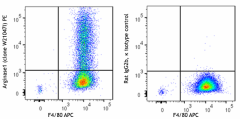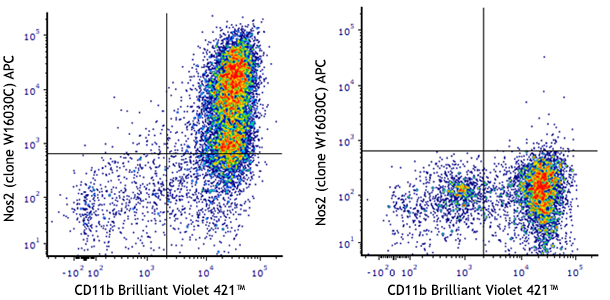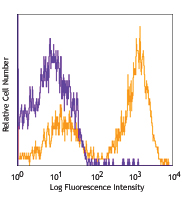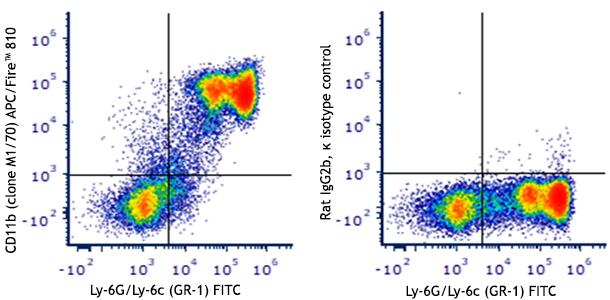- Clone
- W21047I (See other available formats)
- Regulatory Status
- RUO
- Other Names
- Arginase 1, liver type Arginase, Type I Arginase, ARG1
- Isotype
- Rat IgG2b, κ
- Ave. Rating
- Submit a Review
- Product Citations
- publications

-

C57BL/6 mice bone marrow derived macrophages were polarized to M2a for 48 hours with IL-4. Cells were surface stained with anti-mouse F4/80 APC and then fixed and permeabilized with Cyto-Fast™ Fix/Perm Buffer Set and intracellularly stained with anti-mouse Arginase 1 (clone W21047I) PE (left) or rat IgG2b, κ PE isotype control (right).
| Cat # | Size | Price | Quantity Check Availability | Save | ||
|---|---|---|---|---|---|---|
| 165803 | 25 µg | 125 CHF | ||||
| 165804 | 100 µg | 295 CHF | ||||
ARG1 (Arginase 1), is a marker for the M2 anti-inflammatory macrophage subset that hydrolyzes l-arginine into urea and ornithine, and plays an important role in wound healing, antiviral immune responses, and atherosclerosis. The inherited deficiency of this enzyme results in argininemia, which is an autosomal recessive disorder characterized by hyperammonemia. Recent studies show that intracellular pathogens induce the expression of ARG1 in mouse macrophages through the Toll-like receptor (TLR) pathway. The deletion of this enzyme in macrophages favors host survival. Other studies indicate that ARG1 also plays a role in T cell responses and selective antagonists of ARG1 might prove beneficial in fighting diseases in which T-cell responses are inappropriately suppressed.
Product DetailsProduct Details
- Verified Reactivity
- Mouse
- Antibody Type
- Monoclonal
- Host Species
- Rat
- Immunogen
- E. coli expressed protein aa 1-323
- Formulation
- Phosphate-buffered solution, pH 7.2, containing 0.09% sodium azide
- Preparation
- The antibody was purified by affinity chromatography and conjugated with PE under optimal conditions.
- Concentration
- 0.2 mg/mL
- Storage & Handling
- The antibody solution should be stored undiluted between 2°C and 8°C, and protected from prolonged exposure to light. Do not freeze.
- Application
-
ICFC - Quality tested
- Recommended Usage
-
Each lot of this antibody is quality control tested by intracellular immunofluorescent staining with flow cytometric analysis. For flow cytometric staining, the suggested use of this reagent is ≤ 0.125 µg per million cells in 100 µL volume. It is recommended that the reagent be titrated for optimal performance for each application.
- Excitation Laser
-
Blue Laser (488 nm)
Green Laser (532 nm)/Yellow-Green Laser (561 nm)
- Application Notes
-
Clone W21047I does not block the staining of reference clone A1eXF5 on the target cells (BMDM).
- RRID
-
AB_3068116 (BioLegend Cat. No. 165803)
AB_3068116 (BioLegend Cat. No. 165804)
Antigen Details
- Structure
- 322 amino acids with a predicted molecular weight of approximately 35 kD
- Distribution
-
Express on dendritic cells & macrophages. Expressed predominantly in the liver. It can also be induced in macrophages. It is cytoplasmic target.
- Function
- Arginase 1 plays an important role in processes such as wound healing, antiviral immune response, and atherosclerosis.
- Interaction
- Binds 2 manganese ions per subunit as a cofactor
- Ligand/Receptor
- l-arginine
- Cell Type
- Neutrophils
- Biology Area
- Cell Biology, Immunology, Neuroinflammation, Neuroscience
- Molecular Family
- Enzymes and Regulators
- Antigen References
-
- Wu G, et al. 1998. Biochem J. 336:1.
- El Kasmi KC, et al. 2008. Nat Immunol. 9:1399-406.
- Pesce JT, et al. 2009. PLoS Pathog. 5:e1000371.
- Burrack KS, et al. 2014. Front Immunol. 5:428.
- Pourcet B, et al. 2013. Trends Cardiovasc Med. 23:143-52.
- Bronte V, et al. 2003. Trends Immunol. 24:302-6.
- Gene ID
- 383 View all products for this Gene ID
- UniProt
- View information about Arginase 1 on UniProt.org
Related Pages & Pathways
Pages
Related FAQs
- What type of PE do you use in your conjugates?
- We use R-PE in our conjugates.
Other Formats
View All Arginase 1 Reagents Request Custom Conjugation| Description | Clone | Applications |
|---|---|---|
| Purified anti-mouse Arginase 1 | W21047I | ICFC |
| PE anti-mouse Arginase 1 | W21047I | ICFC |
Customers Also Purchased
Compare Data Across All Formats
This data display is provided for general comparisons between formats.
Your actual data may vary due to variations in samples, target cells, instruments and their settings, staining conditions, and other factors.
If you need assistance with selecting the best format contact our expert technical support team.
-
Purified anti-mouse Arginase 1

C57BL/6 mice bone marrow derived macrophages were polarized ... -
PE anti-mouse Arginase 1

C57BL/6 mice bone marrow derived macrophages were polarized ...
 Login / Register
Login / Register 
















Follow Us